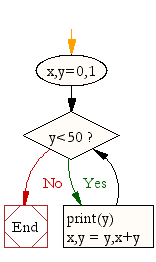- 0-Introduction
- 1-Chatbot Variables
- 2-Password IF Statements
- 3-Create Main Menu functions
- 4-Complete Quiz 3 Questions
- 5-Adding Score variable global
- 6-Debug this code
- 7-Introducing While loops Boolean flags
- 8-Introducing Validation password creation
- 9a-For Loop Guess the number
- 9b-For Loop Password Challenge
- 9c-For Loop Times table challenge
- FINAL CHALLENGE
- Skills Consolidation Task 1
- Test 1
- 0-Introduction
- 1-Introducing Lists
- 2-Personality Predictor Lists app
- 3-Players assigned weapons lists
- 3a-Nested List Matrix Snakes and Ladders game
- 3b Nested List Super Extension Complete game
- 4-String Manipulation Username Creator
- 5-StringManipulation Email Creator based on Validated username
- 6-Strip characters from password app
- 7-Create registration feature using lists
- 8-Introducing Dictionaries registration with dicts
- 8a-Course teacher finder program with dicts
- 9a-Football Club app Create and Learn
- 9b-Online Shopping Basket Checkout Program Create and Learn
- Test 1
- 0-Introduction
- 1-Introducing File Handling
- 2-READ from fake facebook file
- 3-SEARCH for username return no of friends
- 4-SEARCH by ID return full record listing
- 5-ADD WRITE a new user to file
- 6-SORT file by USER ID and Last Name
- 7-Bingo game store scores
- 8-Modulo Magic Program
- 9-Create Maths Quiz Program Tutorial
- 9a-How-to-DELETE user record row from file
- 9b-How to EDIT a field in a file
- Test 1
- 00 Intro
- 01 Main Menu Start Screen
- 02 Registration Feature Part1
- 03 Secure Password Creator
- 04 Login Functionality
- 05 MainFilms Menu Members
- 06 Allow Users to View films
- 07 Store Viewed Films by user
- 08 Allow users to like films
- 09 Search by Title
- 10 Search by Rating
- 11 Recommendations based on viewing FinalSolutions
- 00 Overview Start Here
- 01 Connect Create table
- 02 Add records to table
- 03 Fetch Display records
- 04 Update database records
- 05 Delete records
- 06 Search by condition where clause
- 07 Search for key phrase word
- 08 Sorting in SQLite
- 09 Search return selected fields
- 10 Count no rows
- 11 Find Max Value in column
- 12 Calculate Average
- 13 Calculate SUM total
- 14 Login username password sqlite
- 00-Introduction to OOP and Classes
- 01-Setup Game Canvas
- 02-Create a Ball Class
- 03-Setup main animation loop
- 04-Make the ball move up
- 05-Create bouncing ball movement
- 06-Change Starting Direction
- 07-Right left wall collision detection
- 08-Add Pong bat paddle class
- 09-Bat movement
- 10 Bat Ball collision detection
- 11 End Game Feature if ball hits bottom
- 12 Display text game over
~ OOP,Classes,Python,Tkinter ...recreating PONG
Recreating the classic game PONG! Step 1: Setting up the game canvas
Ready? Make a note of the information below and then get started on the challenges
Pong is one of the earliest arcade video games. It is a table tennis sports game featuring simple two-dimensional graphics. The game was originally manufactured by Atari, which released it in 1972. Allan Alcorn created Pong as a training exercise assigned to him by Atari co-founder Nolan Bushnell. Bushnell based the idea on an electronic ping-pong game included in the Magnavox Odyssey, which later resulted in a lawsuit against Atari. Surprised by the quality of Alcorn's work, Bushnell and Atari co-founder Ted Dabney decided to manufacture the game. We won't be creating the entire game but using the concept to get to grips with object orientated programming and the use of classes. Below is a cool video on "Gaming through time"
Code and Challenge
Copy and paste the code below. Run it! Read the task and see if you can do it before moving on to the next challenge
"""
===========Task==============
1. Type this out for yourself to familiarise yourself with the setup
2. Change the variables/parameters and have a play around - e.g. Game title, background colour, etc
"""
from tkinter import *
import random
import time
tk=Tk() #creating a tk object
tk.title("My 21st Century Pong Game") #give the window a title, using the title function of the tk object
tk.resizable(0,0) #resizable makes the window a fixed size
tk.wm_attributes("-topmost",1) #the wm_attributes tell tkinter to place *this* window infront of all other windows
canvas=Canvas(tk,bg="red",width=500,height=400,bd=0,highlightthickness=0) #create canvas and create a few additional features, passing in parameters for border and thickness
canvas.pack() #tells the canvas to size itself according to the width and height parameters just given
tk.update() #update tells tkinter to initialise itself for the animation in the game to come - this last line is very important as otherwise things wouldn't quite work correctly!
Code your solution here
Systems Life Cycle (in a nutshell): Analyse - Design - Create - Test - Evaluate. Designing something or writing out some pseudocode before you actually write code is always a good idea! Get in to the habit of doing so! You can draw your flowchart here and screenshot it.A sample flow chart (design) for this particular challenge could look like:

Each challenge section below provides an online drawing tool where you can dynamically create flowcharts. Screenshot them into your presentation for submission.
Solutions & Answers
Answers /Solutions in the "members area" drive under: "Solve and Learn >>SOLUTIONS"Testing Table
You may want to read a little about Testing first. A teacher may go through some examples with you. Feel free to fill in the test table here, and screenshot it in to your powerpoint. Testing is absolutely essential once you have created a program!| Test No. | Description | Test Data(input) | Expected Outcome | Actual Outcome | Further Action? |
|---|---|---|---|---|---|
| 1 | |||||
| 2 | |||||
| 3 | |||||
| 4 | |||||
| 5 |